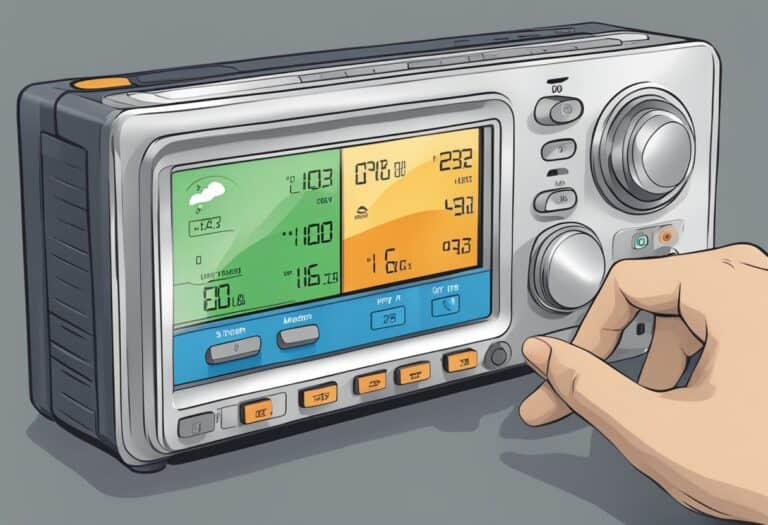Exploring the potential of the AcuRite Iris Weather Station, it’s clear this device is a robust tool for anyone keen on keeping a close eye on local weather conditions.
From monitoring humidity levels for gardening purposes to checking wind speed before a day of sailing, the AcuRite Iris serves as a comprehensive weather monitoring system right at your fingertips.
Well, we’ll be going over:
- What sets the AcuRite Iris Weather Station apart from other home weather monitoring systems?
- How does its detailed weather data and ease of setup benefit daily routines and hobbies that depend on weather conditions?
- Considering its array of features and user-friendly design, is the AcuRite Iris a worthy investment for your home?
With the AcuRite Iris, gaining insight into the weather is not just about practicality; it’s about enriching your daily life with precise and timely environmental data.
Let’s dive in.
Quick Review
For anyone keen on keeping tabs on their local weather with ease, I’d recommend checking out the AcuRite Iris Weather Station. It’s a robust tool that excels in delivering detailed weather data to your fingertips.
Whether you’re a gardening enthusiast or an outdoor adventurer, you’ll appreciate the value it brings. Consider giving this weather station a spot in your home or office. Here’s where you can find the AcuRite Iris Weather Station on Amazon and start enjoying a clearer picture of your weather today.
Overview of the AcuRite Iris (5-in-1) Wireless Weather Station
Recently, I had the chance to try out the AcuRite Iris wireless weather station, and I have to say, the comprehensiveness of the weather data it provides is quite impressive. This device gives you a detailed report of your local weather conditions, bringing together a variety of measurements, including temperature, humidity, wind speed, and rainfall, right in the comfort of your home or office.
What stands out for me is the device’s integrated weather forecasting function. It uses a barometer to capture data at interval and then predicts upcoming conditions with reasonable accuracy once the Learning Mode period has passed. It really feels like you have your own personal weatherman telling you what to expect throughout the day.
The setup is notably straightforward. No intricate assembly is needed; just insert the batteries, mount the sensor, and you’re ready. The large, color LCD display shows your indoor and outdoor readings clearly, along with time and date. It’s like having a weather station and a clock in one.
Yet, it’s not without its limitations. Though touted for ease of use, the data display can be tricky to read from certain angles, which was a minor setback for me. Nevertheless, it’s durable, reliable, and by my experience, a valuable tool for anyone looking to stay ahead of the weather.
Key Features
After spending some time with the AcuRite Iris weather station, I’ve gained a solid understanding of its key features. This device isn’t just another gadget to clutter your space; it’s a comprehensive tool for anyone interested in weather patterns, both hobbyists and those who just like to be prepared for the day ahead. Below, I’ve broken down its standout features which I’ve found to be particularly noteworthy.
Comprehensive Weather Information
The Iris boasts an array of data points—over 55, to be precise. During my time with it, I’ve observed a wealth of information such as historical data, which has been handy for noticing trends. The weather station also provides readings on the heat index, dew point, and what the temperature “feels like,” which differs from the actual temperature. Plus, with a barometric pressure trend arrow, I could see at a glance if a storm was likely approaching.
Real-Time Weather Conditions
Real-time tracking is one of Iris’s standout attributes. The device wirelessly transmits indoor and outdoor temperature and humidity, wind speed and direction, barometric pressure, and rainfall right to the digital display in my home. I’ve found the immediacy of this information especially useful for planning my outdoor activities.
Easiest Setup on the Market
Setting up the Iris was surprisingly simple. After inserting the batteries and mounting the outdoor sensor—which was straightforward thanks to the included bracket—I was ready to go. It’s user-friendly, and I didn’t need to fiddle with too many settings to get it up and running.
Weather Clock
The color LCD display caught my eye right off the bat—it’s large and vibrant, showing the time and date aside from the weather data, which makes it serve a dual purpose. The adjustable dimmer is a subtle but appreciated feature, ensuring that it’s not too bright at night but is still visible from across the room during the day.
Pros
After spending some time monitoring the weather with this station, I appreciate how it displays extensive weather information with precision, offering over 55 data points. This range allows me to track not just the basics like temperature and humidity, but also wind speed and direction, which is crucial for my outdoor planning. Its ease of setup is a standout feature; a simple installation process means you can quickly become the go-to weather expert in your neighborhood.
The digital display is another high point, with its large, color LCD and an adjustable dimmer that enhances readability regardless of the time of day. Crucially, the weather station’s built-in instruments, like the anemometer and rain gauge, provide accurate and hyperlocal weather data, which I find indispensable for my daily weather-dependent activities.
Finally, the brand’s long-standing reputation since 1943 for durable products and responsive customer service adds a layer of trust and reliability to the purchase. Its listings on “Best of” compilates by acknowledged sources echo my positive experience.
Cons
After spending some time with the AcuRite Iris weather station, I have noticed a few drawbacks worth mentioning. While the setup is straightforward, the lack of advanced features might disappoint tech enthusiasts looking for more than basic readings like temperature and wind speed. Additionally, several users have reported issues with Wi-Fi connectivity, which can be frustrating if you’re trying to integrate it with your smart home systems.
The readability of the display poses a challenge for some. If you’re not standing at the right angle or at a certain distance, the numbers can be difficult to read, which might be an inconvenience for those with vision impairments.
Furthermore, although the device is generally robust, a couple of users mentioned their previous models were eventually defeated by extreme weather conditions. Sunlight and hail, in particular, seem to be the natural enemies of the outdoor sensor over long periods.
Finally, for those outside of the US, the inability to switch the date format to UK/European style or change the clock to a 24-hour format could be minor annoyances that detract from an otherwise user-friendly experience.
Customer Reviews
Speaking from experience, the AcuRite Iris weather station has been a reliable companion in my home. With thousands of users weighing in, the general consensus echoes my sentiment; this device boasts a commendable 4.5-star rating. I’ve found the display to be clear and the set-up process straightforward—no fuss involved. Like others, I appreciate the device’s simplicity, though it may not boast an extensive range of features beyond its primary functions.
Durability is another highlight frequently mentioned; my unit has withstood various weather conditions with no decline in performance. Some users have reported a hiccup or two with legibility of the display when not looked at directly, but this is a minor issue in the grand scheme. The lack of Wi-Fi connectivity is noted, yet it doesn’t diminish the overall satisfaction with the product’s core weather-tracking capabilities.
It’s noteworthy that users, including myself, appreciate the ease of installation. The instructions are clearer than most, facilitating a smooth process. Despite a couple of mentions about the inability to customize the date format and operate a 24-hour clock, the consensus remains positive. Moving beyond its functionality, the attractive design of both the indoor and outdoor units is often praised.
In summary, the AcuRite Iris stands out as a sturdy and easy-to-use weather station, consistently meeting the needs of its users, myself included.
Design and Build Quality
Having had my hands on the AcuRite Iris weather station, I can report that it’s quite solid in its construction. The plastic material feels durable, and I’m confident it will stand up well to changing outdoor conditions. Mounting it was simple—no complicated assembly was required, which speaks volumes about its user-friendly design.
The unit’s sleek LCD display is a highlight, with its clear and vibrant screen making it easy to read the data. However, I found that the angles at which you can read the display clearly are a bit limited. If you’re not directly in front of it, the numbers might be harder to discern, which could be an inconvenience for some.
In terms of weather monitoring tools, everything you need is built into the device: an anemometer, wind vane, rain gauge, and more are all integrated into the weather station. It exudes a professional vibe and doesn’t look out of place in a domestic setting.
I did appreciate that the outdoor sensor was wireless, minimizing installation hassles and maintaining a tidy appearance. The indoor console is equally well-made, with buttons and ports that feel robust upon interaction. All in all, my practical experience tells me that AcuRite has paid close attention to the balance between functionality and build quality with the Iris weather station.
Conclusion
After spending some time with the AcuRite Iris weather station, I am impressed by its ease of installation and user-friendly interface. It’s clear from consistent use that the brand prioritizes accessibility; the device connects smoothly with the outdoor sensor, and the display is very easy to read. Despite lacking some advanced features, it undoubtedly serves its primary function as a reliable barometer.
Furthermore, the durability of the model is notable. My experience mirrors that of longtime users who commend the weather station for enduring harsh weather conditions, an important trait for any outdoor device. Although minor drawbacks such as the absence of a 24-hour clock format exist, they don’t overshadow its overall efficiency.
In conclusion, drawing from both my hands-on experience and the feedback from other users, the AcuRite Iris balances simplicity with performance. It’s a solid choice for anyone wanting a straightforward, dependable weather station for their home. Whether you’re a weather aficionado or just like to stay informed of the conditions outdoors, this unit is up to the task.
Frequently Asked Questions
After spending some quality time getting to grips with the AcuRite Iris, a lot of common inquiries spring to mind. Many potential buyers, like you, might be curious about specific aspects of this device. I’ve gathered and addressed several key questions that are bound to be on the tip of your tongue.
How does the AcuRite Iris compare to other professional weather stations?
From my experience, the AcuRite Iris holds its own against other professional weather stations. While some high-end models may offer additional features or connectivity options, the Iris provides a reliable and comprehensive suite of weather measurements. It’s particularly notable for its detailed and personalized forecast, thanks to the Learning Mode that refines its accuracy over time.
Can the temperature and humidity sensor in an AcuRite Iris station be replaced, and if so, how?
Yes, the sensors can be replaced. I found the process to be straightforward: order a replacement sensor from the AcuRite website and follow the instructions provided for syncing it with your weather station. It’s a simple process that ensures your weather readings remain accurate without having to replace the entire unit.
What are the advantages of the AcuRite Iris Weather Station with Color Display?
The Color Display of the AcuRite Iris is not just for aesthetics; it increases readability with vibrant colors that distinguish different weather metrics at a glance. I appreciate the display’s adjustable dimmer, which is useful at night, and the screen generously presents indoor and outdoor data, time, and current conditions without clutter.
What features does the AcuRite Iris HD Weather Station offer for detecting lightning?
One of the advanced capabilities of the AcuRite Iris HD is its lightning detection feature. This function offers alerts for nearby lightning strikes, which is a great safety feature for outdoor planning. It also logs the time of each strike and estimates the distance, which I’ve found quite accurate and useful.
How can I find the manual for my AcuRite Iris (5-in-1) Weather Station?
I located the manual on the AcuRite website in the support section, where it’s available for download. Alternatively, you can contact customer service for assistance. Having the manual handy is a good idea because it offers valuable troubleshooting tips and in-depth instructions on setup and operation.
What should I expect in terms of longevity for an AcuRite weather station?
My previous AcuRite station lasted several years, which matches testimonials from other users. The Iris seems robust as well, especially if maintained properly. The manufacturer suggests that with correct placement and prompt battery changes, the unit should continue to provide accurate data for a good length of time.




![Best Hammock Tarp: Top [year] Picks](https://observationhobbies.com/wp-content/uploads/2024/01/Best-Hammock-Tarp-768x525.png)


![Best Home Weather Stations: Top [year] Picks](https://observationhobbies.com/wp-content/uploads/2024/01/Best-Home-Weather-Stations-768x525.png)